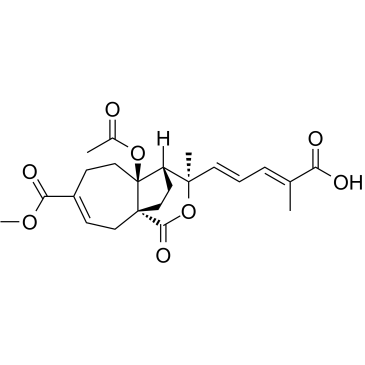Newly discovered angiogenesis inhibitors and their mechanisms of action.
Ze-hong Miao, Jian-ming Feng, Jian Ding
Index: Acta Pharmacol. Sin. 33(9) , 1103-11, (2012)
Full Text: HTML
Abstract
In the past decade, the success of angiogenesis inhibitors in clinical contexts has established the antiangiogenic strategy as an important part of cancer therapy. During that time period, we have discovered and reported 17 compounds that exert potent inhibition on angiogenesis. These compounds exhibit tremendous diversity in their sources, structures, targets and mechanisms. These studies have generated new models for further modification and optimization of inhibitory compounds, new information for mechanistic studies and a new drug candidate for clinical development. In particular, through studies on the antiangiogenic mechanism of pseudolaric acid B, we discovered a novel mechanism by which the stability of hypoxia-inducible factor 1α is regulated by the transcription factor c-Jun. We also completed a preclinical study of AL3810, a compound with the potential to circumvent tumor drug resistance to a certain extent. All of these findings will be briefly reviewed in this article.
Related Compounds
| Structure | Name/CAS No. | Molecular Formula | Articles |
|---|---|---|---|
 |
Pseudolaric acid B
CAS:82508-31-4 |
C23H28O8 |
|
Bcl-2 family proteins were involved in pseudolaric acid B-in...
2008-07-01 [J. Pharmacol. Sci. 107(3) , 295-302, (2008)] |
|
In vitro synergy of pseudolaric acid B and fluconazole again...
2011-09-01 [Mycoses 54(5) , e400-6, (2011)] |
|
Preparative isolation of pseudolaric acids A and B, and thei...
2009-01-01 [J. Sep. Sci. 32(2) , 309-13, (2009)] |
|
Effects of PLAB on apoptosis and Smad signal pathway of hype...
2008-01-01 [J. Asian Nat. Prod. Res. 10(1-2) , 147-57, (2008)] |
|
Topical application of Pseudolaric acid B improve DNFB-induc...
2012-04-11 [Eur. J. Pharm. Sci. 45(5) , 668-76, (2012)] |